
|
|
9 December, 2001
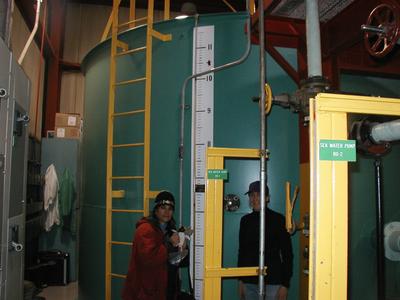
Wendy Kober, operator at the Water Treatment Plant, McMurdo Research Station: (Wendy and I are standing in front of one of the four "fresh water" storage tanks, which hold 50,000 gallons of water each. The green storage tanks are lined in plastic and cleaned once a year.) Since Antarctica is such a remote continent, it must be self-sufficient. If something goes wrong here, it could take days, weeks, months, or years to get part replacements or needed equipment. Where does the McMurdo Research Station get drinkable water to meet the needs of the people who live here during the austral summer months? What do the few remaining scientists and support people do for drinking water when planes can't come during the winter? Wendy Kober explained the "desalination process" as she led Dr. Korsun and me on this informative tour of the water treatment plant. The desalination process involves "making drinking water" by taking the salt out of the seawater. While this may be too expensive to do back home, in Antarctica it becomes a necessity. Before taking the tour, I talked a little with Wendy in order to find out what brought her to this corner of the world. (As I made my way around McMurdo, I often wondered "who" are these people who come to work in Antarctica). Wendy Kober, who is one of the operators at the water treatment plant, first came to Antarctica in 1988 from Minnesota. This is her ninth year in Antarctica, including five winter seasons. This fact alone speaks volumes about Wendy's inner strength, as well as her love for what she does here in Antarctica. (Due to the extreme cold conditions during the austral winter months, it is virtually impossible to leave this continent once the sun sets at the end of February. The extreme cold weather conditions can turn airplane fuel into a substance much like Jell-O. The extreme cold can also freeze equipment, which may keep plane wheels from working properly. It is extremely dangerous for planes to fly in or out of Antarctica during the winter season. People wintering over in Antarctica must take psychological tests in order to stay. People must be mentally and physically fit to stay until the planes return in August). This year Wendy is staying from October to February. After working in "inventory" her first year in Antarctica, Wendy decided that she wanted to work as a boiler operator. (The boilers generated heat, which passed through pipes.) In order to do this, she went home and went to "boiler school". She came back to Antarctica as a boiler operator, but was soon out of a job when boilers were eventually replaced with ones that didn't need a crew. Since two high pressure boilers were in the water plant, she moved to this position.

The desalination process (getting drinking water from seawater) is a fascinating procedure. On our tour of the water treatment plant, Wendy Kober said that seawater, which is 28 degrees Fahrenheit, is heated to 37 degrees Fahrenheit before being pumped at 50 psi (pounds per square inch) into a filter. This 25-micron filter prevents courser materials from flowing through it. This multi-media filter contains a layering of anthracite coal, silica sand, garnet, and gravel (limestone). The filter is not replaced, instead the filter will be cleaned by being backwashed, meaning that it is cleaned by flowing in the other direction).
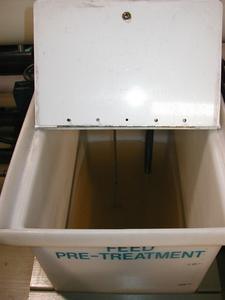
For the next step, polymer (polyacrylic acid) is injected into the water to prevent precipitation onto the membranes. This polymer is stored in the "Feed Pre-Treatment" container.
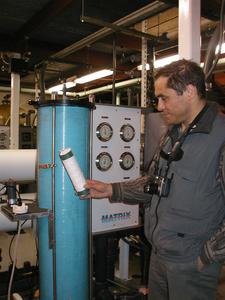
The water then goes through a small blue tank with a five-micron filter. Parcticulates allowed through this filter are getting smaller. The filter, a polypropylene coil that looks like yarn, are replaceable. Dr. Korsun is standing next to the five-micron filter.

The accumulator (the small white tank with five ceramic pistons) keeps water from bouncing as the air-filled bladder within steadies the water. This high-pressure pump, with five ceramic pistons, boosts the pressure from 45 psi to 600 psi. The air-filled bladder dampens down the pressure pulsations caused by the piston pumps. This is important in order to smooth things out as the water changes pressure.

The RO "reverse osmosis" system uses pressure from waste brine (salt from seawater/super saline) to boost the pressure of the seawater. In this process, the waste flow is reversed in order to turn the energy recovery turbo. The energy recovery turbo uses the waste brine to boost the pressure of the seawater from 600 psi to 800 psi before sending the wastewater back into the ocean. This unit requires 800 psi of pressure to make "drinkable water" from this cold seawater. Eighty gallons of seawater per minute goes through this unit. Out of that 80, the water treatment plant gets 28 gallons of fresh water (35%). The water treatment plant has three R/O's (reverse osmosis units), which may generate a possible total of 120,000 gallons of fresh water per day. Since the station's fresh water consumption is below 80,000 gallons per day, only two units are needed. This is a very quick process, which continues 24 hours a day, seven days a week. (Four operators work 12 and a half-hour shifts). Before 1993, they burned 1000 gallons of fuel every day to flash evaporate the water, much like today's distilled water.

The "reverse osmosis" set-up at the water treatment plant
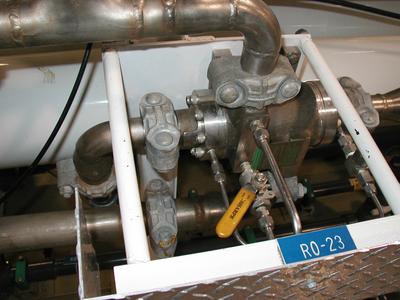
The reverse osmosis valve adjusts how much waste brine is going to go to the energy recovery turbo.

The "cutaway" membrane on display at the water treatment plant indicates where the fresh water comes out of membranes, which are housed in white tubes. The spiral wound membrane has a spacer, which looks like mesh. This allows seawater to get in, while only fresh water molecules will pass through the "paper-like" membrane. There is also a plastic component, which gives fresh water something to ride on as it makes its trip to the center (pipes down the middle).

The mesh allows seawater to get in, while only fresh water molecules will pass through the paper-like membrane.
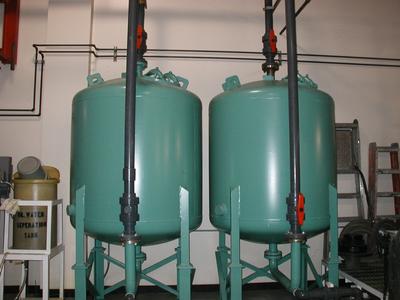
Photo of the Calcium Carbonate tanks: CO2 (Carbon Dioxide) is injected in order to drop the pH. This will enable more calcium to enter the water. (Any time water is being made, the CO2 cylinders must be turned on manually and left on fulltime.) Seawater is very aggressive; it is hard on metals. It will eat the pipes because it wants the mineral (calcite), so calcium will be added to balance the water. As water flows over the calcium carbonate rocks in the green "calcium carbonate tanks", the water picks up more calcium and the pH is raised. The purpose is to get calcium in the water, not only to raise the pH, but also to get enough calcium into the water to precipitate out onto the pipelines.
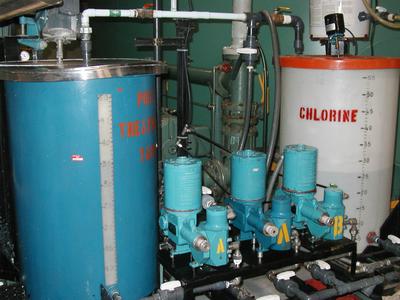
Although the calcium raises the pH, soda ash (stored in the blue "Post Treatment tank") must be added to bring the pH back up to the desired range in order to balance the water after the calcium is added. Chlorine is added in the final step to fight any bacteria that can get through holes in the membrane.

Tests are run periodically to detect coliform bacteria.

The three massive white tanks near the ceiling are expansion tanks for the glycol (antifreeze) waste system heat captured from the radiators at the power plant.
Contact the TEA in the field at
.
If you cannot connect through your browser, copy the
TEA's e-mail address in the "To:" line of
your favorite e-mail package.
|
